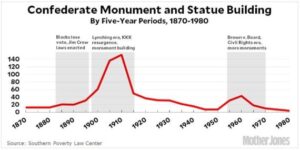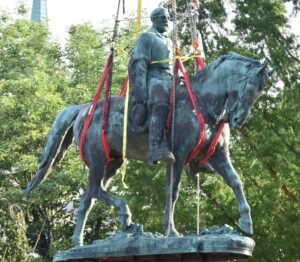In his 2008 book The World Without Us, which tries to imagine what would happen on Earth if all humans suddenly disappeared, Alan Weisman suggested that humanity’s bronze artifacts would be the longest-lasting evidence of our former presence. Other sources (e.g., this article) say bronze can last “indefinitely.”
Bronze is certainly a tough material, famously used in marine fittings because of its strength and corrosion resistance (ships propellers, etc.). For the same reason, it’s often used for statues and sculptures, despite being expensive.
Take, for example, the now-dethroned Robert E. Lee statue in Charlottesville, Virginia (photo below). Commissioned in 1917, and not completed until 1924 (partly because the original sculptor died in 1922 and a replacement had to be recruited), contains a lot of bronze.
A source (found after much searching) says the statue weighs about 12 tons, although it’s unclear whether that includes the concrete base. I suspect so; but even so, there’s gotta be several thousand pounds of bronze there. In any case, a crane was need to left it off its pedestal onto a truck flatbed.
Bronze, though nearly indestructible (although not as indestructible as gold), is easy to cut up with a torch, melt down, and reshape, as its melting point is much lower than steel’s (see table here). So, the obvious and logical way to get rid of an unwanted bronze artifact (e.g., a statue of a traitor) is to cut it up, melt it down, and use the metal for something else.
That’s what the Charlottesville city council has decided to do with Mr. Lee and the horse he rode in on. By unanimous vote, they’re giving the statue (worth about $528,000 in 2019 dollars) to an African-American heritage group who plan to melt it down and use the material for an as-yet-undetermined “art project” (see story here). So, Mr. Lee and his horse apparently won’t be turned into propellers, but they might be transmogrified into black slaves or something like that.
The blitz of post-World War I Confederate monument-building across the South, peaking in the 1920s, coincided with the height of the Ku Klux Klan’s power (see graph below) and was part of an effort to entrench southern white supremacy (see article here). That’s a major reason behind the push to remove these monuments. They were not built by Confederate veterans themselves, to honor their heroes. Most of those veterans were dead by then.
Lee himself disapproved Confederate monuments (see article here), so probably wouldn’t have endorsed this one.
And Lee, who has been heavily mythologized, is no hero. This article puts it bluntly: “Disavowing his oath of loyalty to the U.S., leading a movement to carve up the nation while extinguishing the lives of hundreds of thousands of American soldiers, in the hopes that he and his compatriots could throw off their American citizenship and continue enslaving millions of Black Americans: Lee belongs firmly among the highest ranks of American quislings, mentioned in the same breath as those like Benedict Arnold. For all who can see him clearly, Lee’s treason shines brightly, a century and a half after he led insurrectionists bent on disintegrating this country.”
Lee’s supposed opposition to slavery, or non-involvement in his family’s ownership of slaves, also is a debunked myth. In fact, Lee was deeply involved in managing his family’s slaveholdings (see article here).
Virginia, of course, was Lee’s state of origin, and the beating heart of the Confederacy. Many of the Civil War’s key battles were fought on its soil. Lee’s forces, the Army of Northern Virginia, surrendering there — effectively ending the war. So tearing a prominent Lee statue out of the heart of Dixieland, and handing it over to a black heritage group to turn it into a different kind of history, represents progress toward putting America’s legacy of white supremacy behind us, right?
Not exactly.
Back in 2012, the author of this article optimistically wrote,
“Then fifty years more and finally a certain peace at last. Not without a church bombing, a few more murders, a few crosses burned, but finally a white generation arose with the prejudice gone, for the most part, and the world has now America as an example of a country that has amalgamated into its social and political structure huge populations of Asians, Latins, Caucasians, and Blacks who truly have equal opportunities to share in its wealth.”
Ha. That turned out to be wishful thinking. Sure, it looked that way in 2012, when America’s first black president was re-elected, and Trump was a reality-show host peddling birtherism. But just four short years later, voters (albeit a minority of them) elected a blatant racist to the White House; and today, white supremacy (under guise of opposition to “critical race theory”) is making a full-court press in public schools across the country.
In places like Texas and Tennessee, it’s now illegal for teachers to make white kids feel bad about the nasty things white people have done (and are still doing) to everyone else. Our country is also seeing, currently — not a century ago — a rash of violent attacks against Asians, Muslims, and others by racists incited simply by the victims’ ethnic or religious identity. Clearly, we’re not there, and still have a long way to go.
Nevertheless, melting down Traitor Lee, and letting black people do the melting, if nothing else at least symbolizes a determination by some Americans — including whites — to keep fighting for racial equity and push back against the backlash against it. That’s worth something.
Bronze may last forever, but prejudice and discrimination doesn’t have to. Just as human hands determine what shape bronze will take, human hearts, minds, and consciences decide what shape society will take. Both are in our hands.
Photo: Covered with birdshit, Bobby Lee is headed back to the foundry

